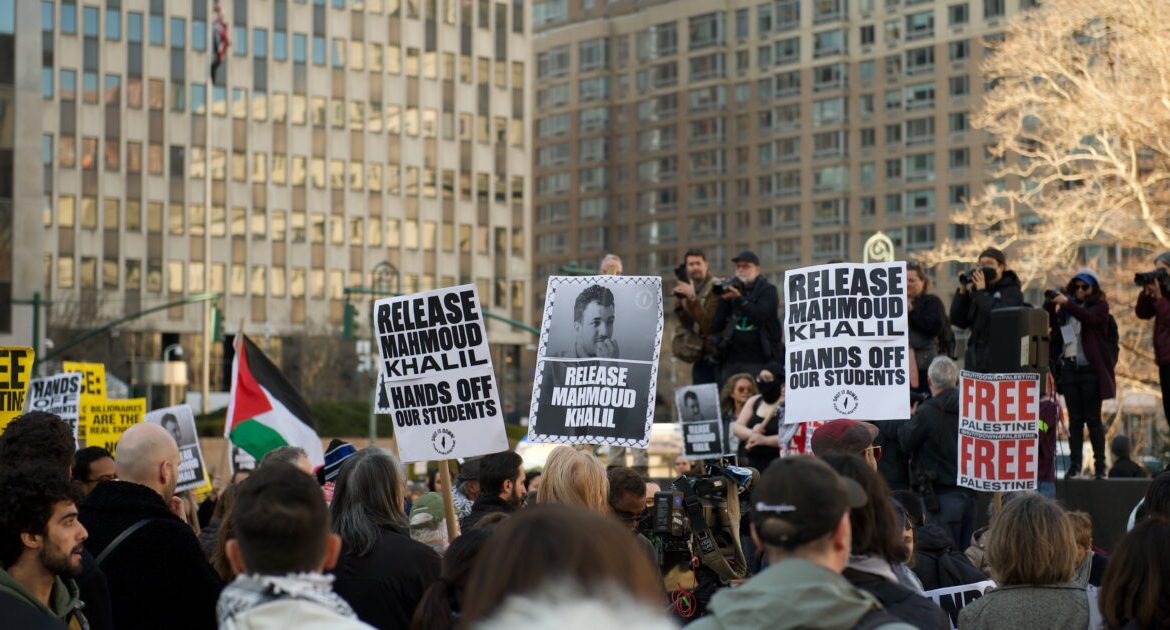
The False Equivalence: Comparing Today’s Pro-Hamas Protests to the Civil Rights Movement Dishonors History


Mahmoud Khalil was released from ICE detention and immediately began leading an anti-America, pro-Iran protest.
A foreign activist with suspected terrorist connections rallying against the country that had just freed him, perfectly encapsulates why comparing today’s campus activism to the civil rights movement is not just historically inaccurate, but morally obscene.
As campus encampments and street demonstrations spread across America, activists and politicians are increasingly drawing false parallels between today’s pro-Hamas protests and the civil rights movement of the 1960s.
Representative Rashida Tlaib recently claimed these protests reflect students being “on the right side of history time and time again,” directly comparing them to civil rights pioneers. But the comparison collapses under scrutiny.
The civil rights movement fought to secure constitutional rights already guaranteed to all Americans but denied to Black citizens under Jim Crow, voting rights, equal protection under law, and access to public accommodations.
Through disciplined nonviolent resistance, the movement broke segregation in public facilities and achieved the most significant civil rights legislation since Reconstruction.
Its strategy included litigation, media engagement, boycotts, sit-ins, and civil disobedience, all aimed at dismantling institutionalized racism and securing legal reform.
Today’s campus protesters pursue entirely different goals. Groups like Columbia University Apartheid Divest praise the leadership of Hamas, Hezbollah, and Ansarallah (the Houthis), all U.S.-designated, Iran-backed terrorist organizations.
Rather than seeking enforcement of American constitutional rights, they promote movements dedicated to destroying America and its ally, while undermining democratic values.
By contrast, the civil rights movement worked through the courts, culminating in landmark decisions like Brown v. Board of Education. Through persistent lobbying and advocacy, its leaders secured transformative legislation, including the Civil Rights Act of 1964 and the Voting Rights Act of 1965.
Today’s campus protesters have explicitly rejected these methods. At Columbia, demonstrators who took over Hamilton Hall scrawled revolutionary slogans such as “Political power comes from the barrel of a gun” on blackboards.
Nerdeen Kiswani, leader of Within Our Lifetime and a prominent figure at the encampment, called for Palestinian “liberation by any means necessary,” including armed resistance.
Today’s campus activists openly advocate for radical upheaval. Their chants, “We don’t want two states, we want 1948” and “From the river to the sea, Palestine will be free”, make their aims clear: the destruction of Israel.
While most Americans today view the civil rights movement as a force for good, today’s pro-Hamas protests are overwhelmingly rejected by the public, who recognize their extremist nature.
With their anti-American rhetoric, revolutionary slogans, and praise for violence, these demonstrations reflect what the Heritage Foundation calls an “unholy alliance” between domestic radicals and foreign terrorist groups, posing a direct threat to the nation’s social fabric.
Unlike the civil rights movement, which had no significant foreign student participation or external agitation, today’s campus protests present a starkly different picture.
Law enforcement officials have noted that many demonstrators are not affiliated with the universities they target.
On May 2, police in New York reported that nearly half of those arrested at Columbia and CCNY were unaffiliated with either school.
Similarly, a University of Texas at Austin official stated that half of those detained during an April 24, 2024 protest had no connection to the university.
These protests have also seen growing involvement from foreign nationals, including individuals allegedly linked to extremist networks.
Since President Trump’s executive order targeting campus antisemitism, the State Department has revoked approximately 300 visas, many held by foreign students involved in pro-Hamas activism. According to the National Association of Foreign Student Advisers, the total number of revoked visas now exceeds 1,000.
The foreign influence extends beyond students. Palestinian activist Mahmoud Khalil, accused by the Trump administration of supporting Hamas and spreading pro-Hamas propaganda, served as a negotiator during encampment talks with school officials.
Another figure, Badar Khan Suri, a postdoctoral fellow at Georgetown’s Alwaleed Bin Talal Center, was described by officials as having “close connections to a known or suspected terrorist.”
U.S. intelligence agencies have further warned that hostile foreign governments are exploiting these protests, spreading disinformation, fueling partisan tensions, and promoting support for Hamas and other terrorist groups.
Unlike the pacifism of the civil rights movement, today’s protesters increasingly glorify violence.
Some have referred to the October 7 attacks as the “Al-Aqsa Flood,” celebrated Yahya Sinwar, displayed the Hamas red triangle symbol, and shouted slogans like “Glory to the resistance!”
Today’s protests undermine core American values. When politicians like Representative Tlaib equate support for designated terrorist organizations with the legacy of the civil rights movement, they weaken the United States and embolden hostile actors—both terrorist groups and foreign powers like Iran that seek to do us harm.
The post The False Equivalence: Comparing Today’s Pro-Hamas Protests to the Civil Rights Movement Dishonors History appeared first on The Gateway Pundit.
